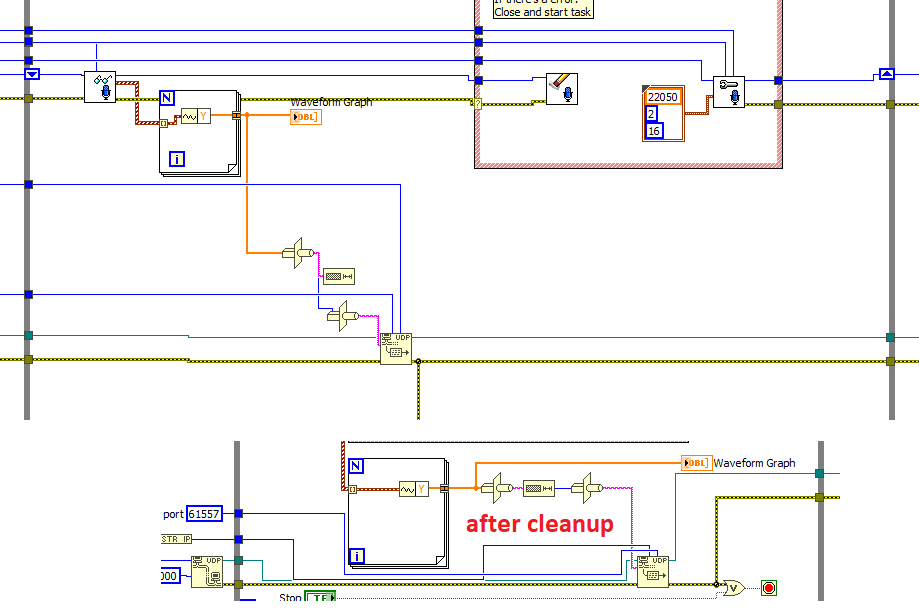- Subscribe to RSS Feed
- Mark Topic as New
- Mark Topic as Read
- Float this Topic for Current User
- Bookmark
- Subscribe
- Mute
- Printer Friendly Page
Rube Goldberg Code
09-19-2018 09:59 AM - edited 09-19-2018 10:08 AM
- Mark as New
- Bookmark
- Subscribe
- Mute
- Subscribe to RSS Feed
- Permalink
- Report to a Moderator
I would say it probably never makes a real difference, but one could of course try to design some very detailed benchmarks. Seems difficult.
If the code to be timed is gigantic and contains many parallel code paths (i.e. many "clumps"), there might still be cases where the "ticker" execution gets delayed if everything is in the same frame because so many other things need to happen in parallel. I have no idea if the compiler would set certain priorities and if "high resolution relative seconds" is prioritized or not.
Out of habit, I probably would keep using the three-frame flat sequence, just because it neatly separates the benchmarkee from the benchmarker. 😄
09-22-2018 01:45 PM - edited 09-22-2018 01:48 PM
- Mark as New
- Bookmark
- Subscribe
- Mute
- Subscribe to RSS Feed
- Permalink
- Report to a Moderator
To generate a list of filenames with incrementing suffix, we of course have this function (which gets expensive if the folder already contains a lot of files, different story).
Assuming we want to roll our own, we could do this: (guess what would happen if e.g. "# of digits" = 0 when we call/run it! 🐵
Or we could of course just do the following. Seems easier. 😮
(Personally, I would even omit the +1, because ABCDEF0000000000.xls is a perfectly good file name, but that's just me :D)
10-28-2018 02:20 PM
- Mark as New
- Bookmark
- Subscribe
- Mute
- Subscribe to RSS Feed
- Permalink
- Report to a Moderator
Is dynamic data really the solution for everything? 😮
Of course we cannot wire a 2D array of DBL to a "Cursor.posX" property node for good reason, because there is no conceivable way this would make sense in any scenario. LabVIEW of course will break the wire.
To avoid the broken wire, all we need is convert the 2D array to dynamic data right? No broken wire>>> No problem! 😄 (This is about as effective as fixing low oil pressure by putting electrical tape over the indicator light.)
11-02-2018 04:46 PM
- Mark as New
- Bookmark
- Subscribe
- Mute
- Subscribe to RSS Feed
- Permalink
- Report to a Moderator
Another one of these dynamic data monstrosities (see here)
(If you are a dynamic data expert, feel free to help the guy out. I am out!)
11-02-2018 05:10 PM
- Mark as New
- Bookmark
- Subscribe
- Mute
- Subscribe to RSS Feed
- Permalink
- Report to a Moderator
@altenbach wrote:
(If you are a dynamic data expert, feel free to help the guy out. I am out!)
Dynamic Data is just whatever is convenient for it to be at that time right? /s
11-02-2018 05:18 PM
- Mark as New
- Bookmark
- Subscribe
- Mute
- Subscribe to RSS Feed
- Permalink
- Report to a Moderator
@Jacobson-ni wrote:
@altenbachDynamic Data is just whatever is convenient for it to be at that time right? /s
OTOH, dynamic data is always inconvenient for the programmer 😄
11-03-2018 10:19 AM
- Mark as New
- Bookmark
- Subscribe
- Mute
- Subscribe to RSS Feed
- Permalink
- Report to a Moderator
@Jacobson-ni wrote:
@altenbach wrote:
(If you are a dynamic data expert, feel free to help the guy out. I am out!)
Dynamic Data is just whatever is convenient for it to be at that time right? /s
That depends on what "Data" can be...in NI's definition and what that configuration wizard will support:D
"Should be" isn't "Is" -Jay
11-05-2018 02:54 AM
- Mark as New
- Bookmark
- Subscribe
- Mute
- Subscribe to RSS Feed
- Permalink
- Report to a Moderator
@altenbach wrote:
@Jacobson-ni wrote:
@altenbachDynamic Data is just whatever is convenient for it to be at that time right? /s
OTOH, dynamic data is always inconvenient for the programmer 😄
Now I finally know why it's called dynamic data. It switches from convenient to inconvenient dynamically.
Almost never back though ![]() .
.
12-29-2018 12:37 PM - edited 12-29-2018 12:37 PM
- Mark as New
- Bookmark
- Subscribe
- Mute
- Subscribe to RSS Feed
- Permalink
- Report to a Moderator
How's that for the ultimate audio compression? (seen here)
So we are reading stereo audio data, concatenate left and right channels into one long 1D array, then all we send over UDP is the size of the flattened string. N bytes to 4 bytes! Seems a little bit lossy... 😮
(Of course things are hard to debug with all these hidden and backwards wires near the typecast, so I took the liberty to also show the same code section after diagram cleanup)
01-02-2019 08:19 AM
- Mark as New
- Bookmark
- Subscribe
- Mute
- Subscribe to RSS Feed
- Permalink
- Report to a Moderator
@altenbach wrote:
How's that for the ultimate audio compression? (seen here)
(Of course things are hard to debug with all these hidden and backwards wires near the typecast, so I took the liberty to also show the same code section after diagram cleanup)

There is something wrong with your cleanup settings. The For loop grew(should have shrunk and the i term is wrongly placed), wires are on top of each other and the int wires cross twice. Tell me that was not a Ctrl+U result
"Should be" isn't "Is" -Jay
